Life with the Lenovo Yoga 2 Pro
by Brett Howse on July 30, 2014 2:00 PM EST- Posted in
- Notebooks
- Lenovo
- Windows 8.1
- Yoga
Battery Life
The Yoga 2 Pro contains an integrated 55Wh battery inside, which compared to a tablet first device like the Surface Pro 3 with its 42Wh battery is a good size. However, with a high resolution 3200x1800 screen to drive, battery life is not spectacular, especially at light workloads.
First we consider the light workload test. We use the default browser (in this case IE 11) going through a standard workload of web browsing with the display set at 200 nits. The default setting is to hibernate the machine when the battery gets to 5%, and to avoid damage to the battery this was not changed, so please note these times are from 100% charge to 5% charge.

Battery life of the Yoga 2 Pro is not its strong point, with the battery life near the bottom end of our charts. A big part of this is likely the display. In order to achieve 200 nits, the display had to be set at 94%, which is fairly high. High resolution has its drawbacks and this is one of them.
Next up we compare it to other devices with a heavy workload.
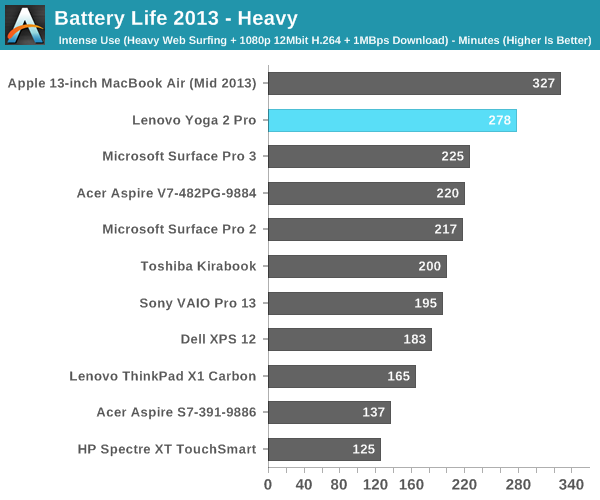
Here, where the display is no longer the largest battery draw, the Yoga 2 does very well. The heavy workload shifts the results from being optimized for mostly idle with the display drawing the majority of the power to a scenario where the CPU, GPU, and Wi-Fi are all in use and the percentage of overall power draw by the display is less. Still the results here are a bit surprising. It is possible there is something drawing excessive power at idle that isn’t an issue when the device moves off idle, or it could just be the display. Either way, it’s a much better showing on the heavy battery test.
Next we'll look at the battery life normalized to compare platform power use and remove the battery size from the equation.
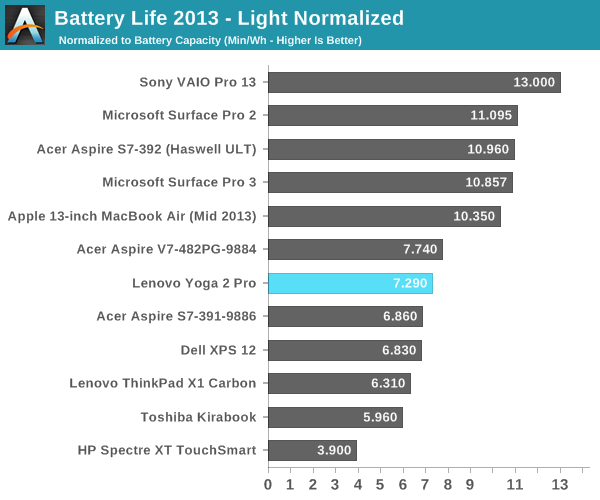
Here we can see the effect of what is likely the display power draw at idle. The Sony VAIO Pro has the same Core i5 inside, but Sony really did a great job on overall platform power. The Sony has an easier to drive 1080p display which also helps. Microsoft's Surface Pro 2 and 3 both have Haswell Core i5 processors as well. The Yoga 2 Pro also benefits by having a larger 55Wh battery inside to compensate for the higher idle platform power draw.
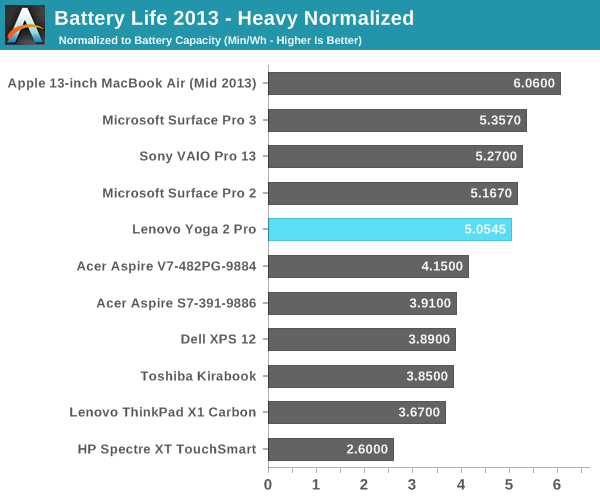
On the heavy workload, as discussed earlier, the overall percentage of power draw of the display is reduced. Here we see the Yoga 2 Pro much more in-line with the other Haswell Core i5 devices.
Charging Times
The Yoga 2 Pro ships with a 65 watt power adapter with a reversible plug. Though the adapter is 65 watts, normally the battery will charge with a 22 watt rate which decreases as the battery gets charged. Charging times are a function of charge rate versus battery size, which for the Yoga 2 Pro is 22:55.
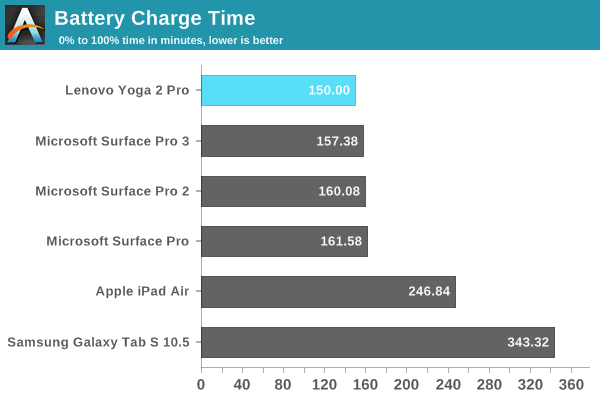
The charge times are pretty good, with the Yoga 2 Pro being able to go from 5% to 100% in 2.5 hours. It is a bit quicker than the Surface Pro 3, even with a larger battery on the Yoga 2 Pro. But Lenovo has a trick up its sleeve here as well. The Yoga 2 Pro has an optional express charging mode, where the initial battery charge power jumps from 22 watts to 44 watts. This has a significant impact on charging times.
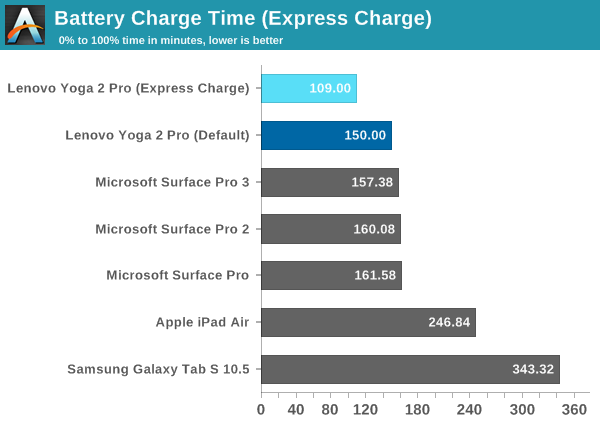
The Express Charge option drops the charge time to 109 minutes. The express charge requires 28% less charging time than the standard charge. The obvious question is why don’t they just leave it at 44 watts all the time? It gets into battery chemistry, but the higher charge rates can cause a quicker breakdown of the battery. Lenovo has likely chosen a conservative value for the standard charge in order to keep warranty claims low. Since this is a personal laptop, it likely won’t need the express charge treatment very often.
Temperatures
At idle, temperatures stay pretty low with the CPU sitting around 45°C, and the laptop itself never gets warm during light workloads.
Stressing the device for fifteen minutes, the temperatures rose up to around 80°C on the CPU. At this point, the laptop was certainly warm to the touch, but it wasn't hot.
While stressing the CPU, I also captured the CPU clock speed to see if it would throttle under prolonged high loads, but the Yoga 2 Pro never went under the advertised base clock speed of 1.6GHz with both cores (all 4 threads) at 100% usage, though it does drop quite a bit from the maximum 2.6GHz clock speed.
Noise
The Yoga 2 Pro has a fan, but in normal operations it stays fairly low so it isn’t very audible. With the default power profile, when the Yoga 2 Pro is plugged in, the fan is active but quiet, and when on battery power it switches to passive as the default cooling option. It's only if you stress the device that the fan spins up at all, and generally it stays quiet. It is not silent like a tablet would be, but it also has a lot more performance. If you push the device the fan will spin up though in either mode.
I don't have an accurate dB meter (yet), and attempts to capture the sound resulted in more noise from the room than the laptop. It's certainly not silent, but with no dedicated graphics to keep cool, the overall noise is very reasonable. Under intensive workloads, the fan spins up and is very audible, however the only time it has ever been at this level was during stress testing. Normal usage, even light gaming, was audible but not loud.




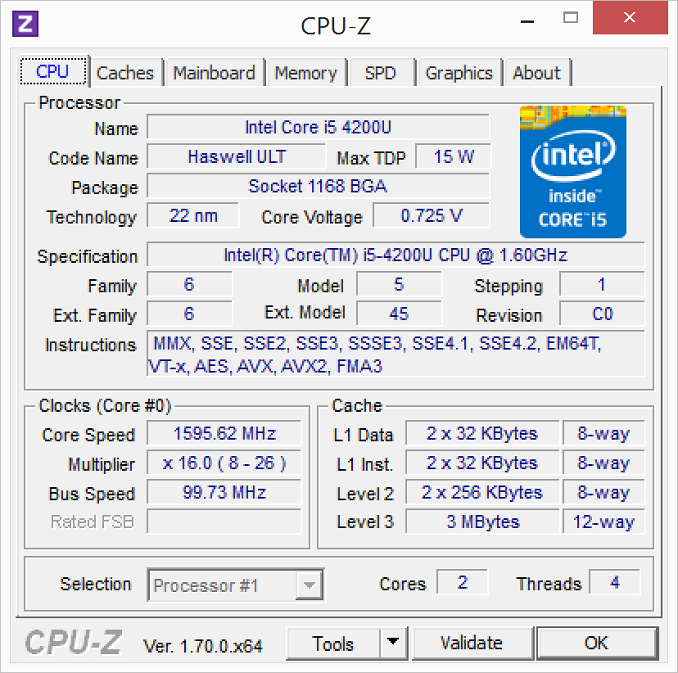








103 Comments
View All Comments
NeatOman - Tuesday, September 25, 2018 - link
4+ years later, after two annoying issues and a new SSD which i wouldn't put against the machine as its normal wear IMO I still very much love the machine (i5, 4GB, 256GB, 3200x1800). The first issue that bothered me was the yellow tint which was fixed in a BIOS update. Then the Windows 10 update that caused flickering drove me nuts, not only did it take me a few days to figure out that the adaptive refresh rate was bugging out.. but that then with Automatic updates being forced on all Windows 10 machines (I upgraded ASAP to Win10) kept resetting my display driver settings every few months.But after that, upgrading the SSD because the old one died, upgrading the thermal paste (stays locked @2.3GHz under full load), and upgrading the WiFi to an Intel AC one it feels every bit as fast as any other machine for basic use. And the screen is on par with anything new, other than the very few HDR10/OLED screens out there. 3200x1800 on a 13" is GREAT for 200% scaling as its effectively the same text/graphical size as a 1600x900 screen at the same size (IMO 1080p is marginally too small at 13").
I've never been satisfied with a laptop, and never kept one for over 2 years. From a beautiful Sony VAIO in 2004, with switchable Nvidia graphics then another Sony VAIO with a Blu-ray Burner lol to a Thinkpad to a 2008 13 MacBook Pro (kept that one on the side for a long time) then a ASUS UL30VT-X1 which had 10+ hours of real battery life, then the mistake of selling it and getting a 1st gen Surface Pro and getting another Thinkpad and landing at the Yoga 2 Pro.
That's my story for the day HAHAHA I'm sitting on a job waiting for an Invoice to be processed typing away on my Yoga 2 Pro and just thought how much i enjoy it.